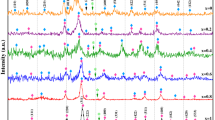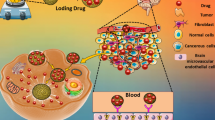Abstract
In this project, Calcium ferrite/polyvinyl alcohol (CaFe2O4@PVA) nanocarriers were prepared by a thermal-treatment method at three different temperatures (773, 823 and 923 K). The nanocarriers were used as drug delivery systems (DDS) to deliver curcumin (CUR) and were utilized as a new structure for photo dynamic therapy (PDT). Drug loading and release study of CUR were performed and it was observed that nanocarriers showed a pH dependent drug release behavior. MTT assay, Hemolysis assay and lethal dose test were applied to determine the cytotoxicity of nanocarriers. These tests indicated that synthesized nanocarriers can be considered as nontoxic. Also, the photodynamic therapy experiments were performed by two groups: one group of cells were treated by different concentrations of nanocarriers without light and the other group were exposed to light. Then, the efficacy of PDT was determined by MTT and it was revealed that whenever nanocarriers were exposed to light the cytotoxicity was significantly high. Therefore, it was revealed that these nanocarriers are suitable to be utilized as a drug delivery systems and photo dynamic therapy agent.
Graphic Abstract







Similar content being viewed by others
References
J.W. Park, Liposome-based drug delivery in breast cancer treatment. Breast Cancer Res. 4(3), 95 (2002)
M. Aghajanzadeh et al., The role of miktoarm star copolymers in drug delivery systems. J. Macromol. Sci. Part A 55(7), 559–571 (2018)
M. Aghajanzadeh et al., Anti-inflammatory effect of rosuvastatin using diblock amphiphilic copolymer: Synthesis, characterization, in vitro and in vivo study. J. Biomater. Appl. 34(2), 229–238 (2019)
M. Zamani et al., In vivo study of mPEG–PCL as a nanocarriers for anti-inflammatory drug delivery of simvastatin. Pharm. Dev. Technol. 24(6), 663–670 (2019)
S. Kossatz et al., Efficient treatment of breast cancer xenografts with multifunctionalized iron oxide nanoparticles combining magnetic hyperthermia and anti-cancer drug delivery. Breast Cancer Res. 17(1), 66 (2015)
K. Cho et al., Therapeutic nanoparticles for drug delivery in cancer. Clin. Cancer Res. 14(5), 1310–1316 (2008)
N. Nasongkla et al., Multifunctional polymeric micelles as cancer-targeted, MRI-ultrasensitive drug delivery systems. Nano Lett. 6(11), 2427–2430 (2006)
T. Zargar, A. Kermanpur, Effects of hydrothermal process parameters on the physical, magnetic and thermal properties of Zn0.3Fe2.7O4 nanoparticles for magnetic hyperthermia applications. Ceram. Int. 43(7), 5794–5804 (2017)
N. Sulaiman et al., Synthesis and characterization of CaFe2O4 nanoparticles via co-precipitation and auto-combustion methods. Ceram. Int. 44(1), 46–50 (2018)
A.K. Das, R. Govindaraj, A. Srinivasan, Structural and magnetic properties of sol-gel derived CaFe2O4 nanoparticles. J. Magn. Magn. Mater. 451, 526–531 (2018)
Y. Qu et al., Enhanced magnetic fluid hyperthermia by micellar magnetic nanoclusters composed of MnxZn1–xFe2O4 nanoparticles for induced tumor cell apoptosis. ACS Appl. Mater. Interfaces 6(19), 16867–16879 (2014)
Q.A. Pankhurst et al., Applications of magnetic nanoparticles in biomedicine. J. Phys. D Appl. Phys. 36(13), R167 (2003)
T. Kondo et al., Alternating current magnetic susceptibility and heat dissipation by Mn1−xZnxFe2O4 nanoparticles for hyperthermia treatment. J. Appl. Phys. 117(17), 17D157 (2015)
M.G. Naseri et al., Synthesis and characterization of zinc ferrite nanoparticles by a thermal treatment method. Solid State Commun. 151(14–15), 1031–1035 (2011)
M.G. Naseri et al., A comprehensive overview on the structure and comparison of magnetic properties of nanocrystalline synthesized by a thermal treatment method. J. Phys. Chem. Solids 75(3), 315–327 (2014)
F. Dumestre et al., Superlattices of iron nanocubes synthesized from Fe[N(SiMe3)2]2. Science 303(5659), 821–823 (2004)
S.-J. Park et al., Synthesis and magnetic studies of uniform iron nanorods and nanospheres. J. Am. Chem. Soc. 122(35), 8581–8582 (2000)
M.-P. Ginebra, T. Traykova, J.A. Planell, Calcium phosphate cements as bone drug delivery systems: a review. J. Control. Release 113(2), 102–110 (2006)
M. Naseri, E. Naderi, A.R. Sadrolhosseini, Effect of phase transformation on physical and biological properties of PVA/CaFe2O4 nanocomposite. Fibers Polym. 17(10), 1667–1674 (2016)
P.A. Botham, Acute systemic toxicity—prospects for tiered testing strategies. Toxicol. In Vitro 18(2), 227–230 (2004)
M. Zamani et al., In vivo study of poly (ethylene glycol)-poly (caprolactone)-modified folic acid nanocarriers as a pH responsive system for tumor-targeted co-delivery of tamoxifen and quercetin. J. Drug Deliv. Sci. Technol. 54, 101283 (2019)
M. Aghajanzadeh et al., In vivo and in vitro biocompatibility study of MnFe2O4 and Cr2Fe6O12 as photosensitizer for photodynamic therapy and drug delivery of anti-cancer drugs. Drug Dev. Ind. Pharm. 46(5), 846–851 (2020)
P. Verbrugghe et al., An electro-responsive hydrogel for intravascular applications: an in vitro and in vivo evaluation. J. Mater. Sci. Mater. Med. 26(11), 264 (2015)
E. Naderi et al., Improving the anti-cancer activity of quercetin-loaded AgFeO2 through UV irradiation: synthesis, characterization, and in vivo and in vitro biocompatibility study. J. Drug Deliv. Sci. Technol. (2020). https://doi.org/10.1016/j.jddst.2020.101645
K. Patel et al., Novel folic acid conjugated Fe3O4-ZnO hybrid nanoparticles for targeted photodynamic therapy. Colloids Surf. B 150, 317–325 (2017)
M. Zamani et al., Co1—XZnxFe2O4 based nanocarriers for dual-targeted anticancer drug delivery: synthesis, characterization and in vivo and in vitro biocompatibility study. J. Mol. Liq. 274, 60–67 (2019)
O.O. Guideline, 425: acute oral toxicity—up-and-down procedure. OECD Guidel. Test. Chem. 2, 12–16 (2001)
Acknowledgements
This work has been supported financially by the Faculty of Pharmacy, Zanjan University of Medical Sciences and Malayer University. This work is a part of Dr. Ehsan Naderi’s Ph.D. thesis.
Author information
Authors and Affiliations
Corresponding authors
Ethics declarations
Conflict of interest
The authors declare that they have no conflict of interest.
Additional information
Publisher's Note
Springer Nature remains neutral with regard to jurisdictional claims in published maps and institutional affiliations.
Rights and permissions
About this article
Cite this article
Naderi, E., Aghajanzadeh, M., Zamani, M. et al. The Effect of Calcination Temperature on the Anticancer Activity of CaFe2O4@PVA Nanocarriers: Photodynamic Therapy and Drug Delivery Study. J Inorg Organomet Polym 30, 5261–5269 (2020). https://doi.org/10.1007/s10904-020-01653-z
Received:
Accepted:
Published:
Issue Date:
DOI: https://doi.org/10.1007/s10904-020-01653-z




